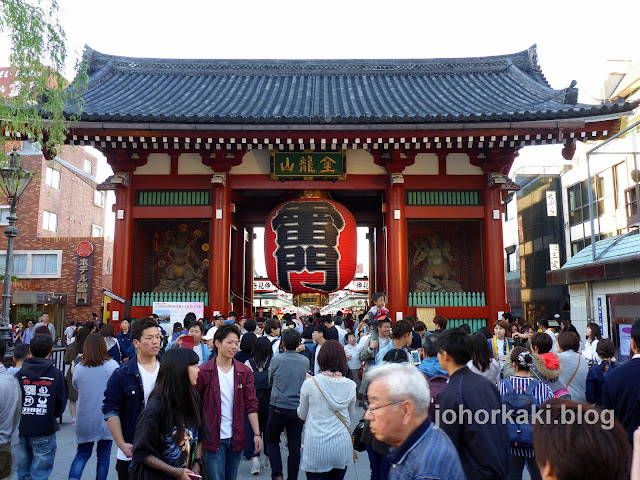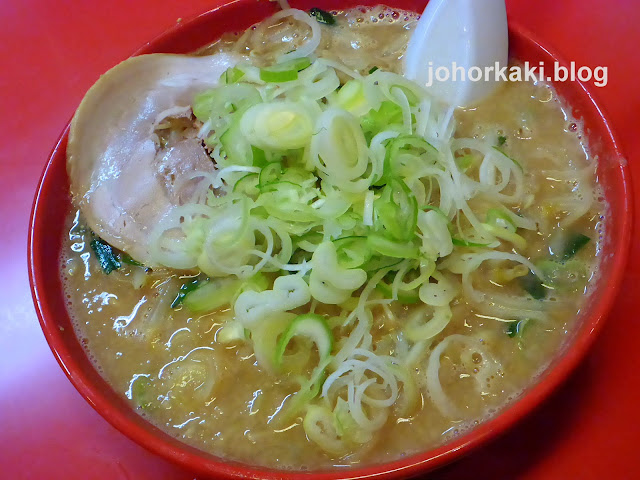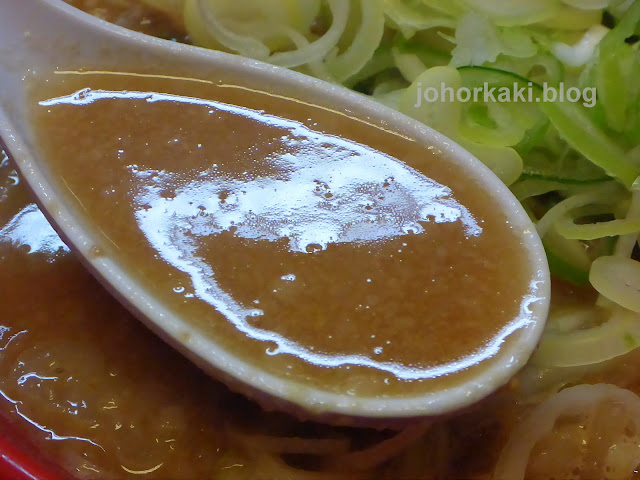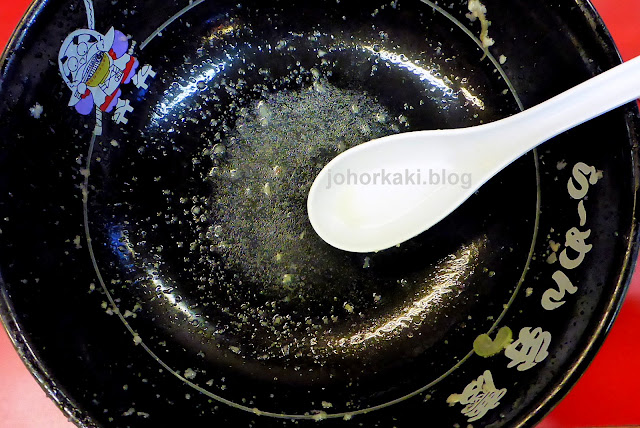
Dropped by Asakusa today for a day of sightseeing at Sensō-ji Temple, one of Tokyo's most important shrines, popular with both domestic and overseas visitors. The Kaminarimon (dedicated to the God of Thunder 雷神) which is the first of two gates leading to Sensō-ji Temple was crowded with visitors to the revered shrine.

The Kaminarimon Gate is Asakusa's "rickshaw terminal". For a small fee (starting at ¥6,000), the rickshaw driver will take you on a tour of colourful Asakusa entertaining you with witty running commentaries, while you sit back, relax and enjoy the sights.

I asked one of the young, strong and handsome (they all are) rickshaw drivers who was taking his break, "Where can I get a good ramen in Asakusa"? Haruki-san's first reflexive response was "Ippudo" - I did saw an Ippudo outlet steps from Kaminarimon Gate but a chain store wasn't what I had in mind.
I rephrased my question. "Where do you go for ramen?" "Eh... there is a ramen street..." I was so excited to hear this and Haruki's eyes lit up too as he shared his favourite ramen shop with a stranger. Haruki then drew me a sketch map and wrote down the words 弁慶 for me as the ramenya has no English signage.
(Japanese people are always so warm and helpful whenever I asked for help even though I speak no Japanese at all.)

Following Haruki's sketch map, I walked through the narrow row of little traditional food and souvenir shops leading to the Senso-ji Temple. The row of stalls known as Nakamise Dori was barely passable as I slowly worked my way forward through the thick crowd, thicker than 弁慶's pork bone broth (which I soon found out is the thickest I have ever tasted so far).

The visitors were in their Sunday best including quite a few in their beautiful floral kimonos.

Hozomon, the second gateway to the Sensō-ji Temple main hall.
Founded in 628 AD, Sensō-ji Temple 金龍山浅草寺 is Tokyo's oldest Buddhist temple. The temple is dedicated to Kannon (Kuan Yin, the Buddhist Goddess of Mercy). Over thirty million visitors a year worship here.
(The temple complex is a reconstruction completed in the 1960s as the original buildings were destroyed by bombing during the Second World War.)

A long line of worshippers queued patiently up the steps to take their turns to dedicate their silent prayers to Kuan Yin at Sensō-ji Temple's main hall.

After passing Senso-ji Temple, I continued north for another 200 metres until I am on Kototoi Ave (which runs east-west). Here at the junction, I turned right heading east.
Many Tokyo buildings appear drab and utilitarian. Most were built after the Second World War during which the Americans carpet bombed the heart of the city, razing much of Tokyo to the ground with fire bombs.

Not quite the "ramen street" I imagined but I passed 5 little ramenyas over the half kilometre stretch along Kototoi Ave before arriving at 弁慶.
I found 弁慶 easily, thanks to Haruki's simple and clear sketch. (I should have taken a picture of the sketch and post it here 😔 )

I took a quick peek inside each of the ramenyas I passed at Kototai Ave and 弁慶 had the most customers inside at dinner time.

Inside 弁慶, it's a small, simply furnished space for about 20 diners just as Haruki
Inside 弁慶, it's a microcosm of Tokyoites. There were families with children and the little ones were familiar with the kitchen crew. I love how polite Japanese children are. There were tired looking middle aged salary men still in their well worn business suits after a day's drudgery. There were young courting couples. Working men in soiled overalls from the day's labour. Lone diners. And, one camera togging tourist 😂

Ordering is simple once I was able to master the system. The "cashier" is actually a vending machine. We just slot in the stated amount of money in the simple menu, and then punch the button for the ramen that we chose. The vending machine will dispense a ticket and gives change.
Hand the ticket to the staff who will pass that on to the kitchen.
I think this simple system is a smart productivity idea that does not compromise on the quality of food served. It's an idea we could adopt in Singapore, especially if the menu is relatively simple 😄

I ordered a ramen flavoured with salt (price ¥730). The ramen came in a huge deep bowl. The noodles were submerged in a thick broth and there were lots of bean sprouts and chopped leek piled on top. There was also a single slice of chashu and a couple of strips of crunchy pickled bamboo shoot. (There was no runny flavoured tamago egg, nor dried seaweed.)
It was a huge deep bowl of noodles in pork bone broth. So... this is where the rickshaw drivers get high octane fuel to power the human powered rides around Asakusa.

There was plenty of sweet tasting crunch from the chopped leek and blanched bean sprouts.

The curly ramen noodles were heavy gauge. It wasn't done al dente in the wanton mee or spaghetti sense - it's more of a tender bite with soft firm chewiness mainly from the thickness and weight of the wheat noodles.

The single slice of chashu was thin but tender and juicy. It had a mix of fat and lean meat yielding a nice assertive natural porcine sweetness which I like.

The main thing that struck me was 弁慶's full bodied, thick pork bone broth. It felt like finely mashed pork fat was thrown into the broth and boiled till it melted. The broth had a nice deep savouriness. The salt added another layer of flavour to the robust broth and seemed to sharpened it.

All around me, locals were enjoying their ramen.
Like them, I blew quick puffs of breath at the steamy hot noodles in vain attempts to cool it down. Then, I slurped the thick heavy noodle into my mouth self consciously - it's impossible to do this without making that famous slurping sound as the thick wet strands whipped and twirled before they disappeared between our sucking lips. But, before I knew it, I was slurping happily like everyone else 😁
I don't know a word of Japanese but understood exactly what the chorus of slurps resonating all around the little ramen shop mean. It's a kind of comfort and contentment that makes a place a home and the people around you, your community, if not family. I felt welcome as it embraces overseas visitors who also slurp with oblivious abundant.

After enjoying the solid ramen at 弁慶, I walked around Asakusa to burn off some of the million calories. Night had fallen and the crowd at Kaminarimon Gate had subsided, but only by a little.

Street food is alive and well in Tokyo. The food street was filled with the aroma of food such as seafood sizzling over smoking grills and tempura frying in deep woks of boiling hot oil.

The shops were full of young people who filled the air with a cacophony of cheerful banter, exuberant laughter and infectious energy. Street food is very happening here - it is part of being Japanese.
As I do not foresee myself passing this way again in the near future, I decided to have another go of ramen at 弁慶 😂

For my second round, I went for the miso flavoured version (price ¥780).
弁慶 was still as busy when I came back a second time just an hour apart. The friendly staff and kitchen crew were surprised, wondering who is this strange guy with the camera? I guess it's not often that a customer ordered two bowls of ramen for himself in succession, especially as 弁慶's servings are huge. Maybe, they are worried for my arteries 😂

It's the same crunch from the heap of chopped leek and blanched bean sprouts. There was also the same heavy gauge noodles.

This time the heavy creamy pork bone broth was flavoured with umami savoury miso. It is very nice too, but if I had to choose between miso or salt, my preference would be salt. With salt the savoury layers felt more distinct and layered. With miso, the layers seemed to meld together thus tending to flatten the flavours a little.

Half way through the second bowl, I also indulged in a couple of spoonfuls of chili oil for a bit of mild spicy kick. I enjoyed this version too.

4-Star (out of 5). If you like your ramen broth to be very heavy, creamy, just a notch from being an emulsion, you will like 弁慶's ramen. I like the deep savoury flavour of 弁慶's rich pork bone broth. I also enjoyed the juicy crunch from the generous mound of leek and bean sprouts at 弁慶.
However, the heavy gauge noodles were average to my ramen goondu (novice) taste buds. If you are in Asakusa and want to eat ramen, maybe you would like to check out 弁慶 which is the local no frills, no gimmicks favourite. It's right at the fringe, a stone's throw away, just outside the tourist belt. It's 15 minutes walk from Karminarimon Gate subject to human traffic 😂

Restaurant name: ラーメン弁慶 (referred to as Ramen Benkei Asakusa in the shop's own website)
Address: 〒111-0033 Tōkyō-to, Taitō-ku, Hanakawado, 2 Chome−17−9, Japan
GPS: 35°42'54.9"N 139°48'03.0"E | 35.715235, 139.800832
Tel: 03-5828-7355
Hours: 11:00am to 4:00am
Non Halal

Restaurant name: ラーメン弁慶 (referred to as Ramen Benkei Asakusa in the shop's own website)
Address: 〒111-0033 Tōkyō-to, Taitō-ku, Hanakawado, 2 Chome−17−9, Japan
GPS: 35°42'54.9"N 139°48'03.0"E | 35.715235, 139.800832
Tel: 03-5828-7355
Hours: 11:00am to 4:00am
Non Halal
Date visited: 4 May 2017
Written by Tony Boey on 4 May 2017 | Reviewed 6 Aug 2023
🎗 Opinions in this blog are all my own as no restaurant or stall paid money to be featured


Hi Tony,
ReplyDeleteI encountered the same vending machine ordering system when I was in Seoul last year. Had me flummoxed as we were sitting at the table waiting in vain for someone to take our order until the proprietor pointed us to the vending machine. The vending machine system at 弁慶 ( Benkei - Strong Man ) is it unique to most of the Japanese restaurants ?
I was puzzled too at first as I took a menu and went over to the staff to show him what I wanted. Then, he showed me how to use the machine. I noticed later that it is rather common in Tokyo, especially for small shops like Benkei. Do you know the Japanese language? (Seems like you do :-D )
ReplyDelete弁慶 ( Benkei - Strong Man )
DeleteGoogle Translate Tony, Google Translate.
That's what I use when I need a quick translation :-)
Thanks! :-D
Delete